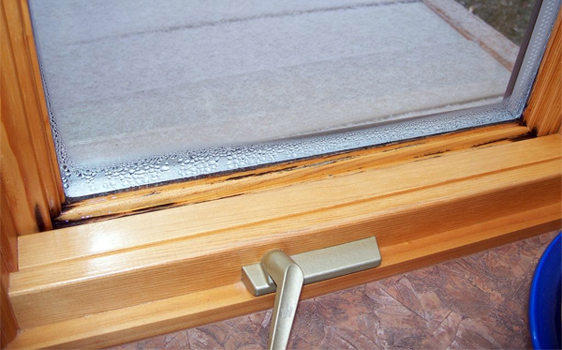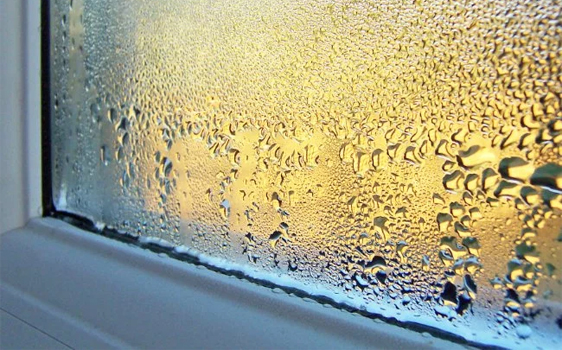Window Condensation
How Condensation Forms
Window condensation is a very negative aspect of humidity that can appear on your windows at any given time, typically with temperature differences between the surface of the window, the room indoors and the outdoor temperature. At the point that the temperature reaches the ‘dew point’ level, that is when your windows ‘show off’ the built-up humidity in the air, and the change in the air temperature condenses the air to actual water. Window condensation can be derived from multiple sources, and even just a handful of them can cause you the condensation issues. When windows cannot be opened during seasons that are colder, this is a prime time for all of the humidity-driven sources of your home to kick into high gear, as the open windows that causes air flow is taken away (making each room of your home more air tight).
Unchecked Condensation Damage
 Water itself, on any type of surface, that is left unchecked and remains, will cause long-term damage over a short period of time. Window condensation is especially damaging because it is not just the window that gets soaked with moisture, it is usually the tracks, the framing and the surrounding wall. If left and not repeatedly dried immediately, the damage can run down the wall the window is mounted in, and eventually damage the flooring as well. The first signs that the condensation issue is getting out of hand is clear evidence of deterioration & rotting of framing & walls, especially if the framing that holds the windows is wood, if that becomes weakened by rot, the windows are in jeopardy of loosening in the wall. Some windows like picture windows, bay & bow windows and multiple casement windows are larger and are heavier, which really puts you in danger if the framing lets go at any point. Considering how much damage your home could sustain from ignored window condensation, would it not be worth your time to take steps to reduce humidity in your home, and keep any moisture collected wiped & dried so as to not get out of hand?
Water itself, on any type of surface, that is left unchecked and remains, will cause long-term damage over a short period of time. Window condensation is especially damaging because it is not just the window that gets soaked with moisture, it is usually the tracks, the framing and the surrounding wall. If left and not repeatedly dried immediately, the damage can run down the wall the window is mounted in, and eventually damage the flooring as well. The first signs that the condensation issue is getting out of hand is clear evidence of deterioration & rotting of framing & walls, especially if the framing that holds the windows is wood, if that becomes weakened by rot, the windows are in jeopardy of loosening in the wall. Some windows like picture windows, bay & bow windows and multiple casement windows are larger and are heavier, which really puts you in danger if the framing lets go at any point. Considering how much damage your home could sustain from ignored window condensation, would it not be worth your time to take steps to reduce humidity in your home, and keep any moisture collected wiped & dried so as to not get out of hand?
Susceptible Areas
 The most susceptible areas for window condensation is the lower sash bottom at the glass interior, and the meeting rail. This is due to the cooling of warm air to fall on the interior surface, with decreasing room temperature (the air contacts the meeting rail at its horizontal surface & the rate of the fall of air slows down to let the trapped water vapour to escape). This air now rolls over the meeting rail edge to pick up speed until it arrives at the sash lower handle, and the water vapour escapes again to sit at the sash bottom and begins forming (noticeable moisture collection). Left alone long enough without drying, the moisture begins to collect around and on the framing if not moisture repellent like vinyl material. Thinking about the humidity levels in your home, if your windows are newer and working exactly as they should (functioning properly, installed correctly, all seals and joints are damage-free), or, if they are older, but still in sound condition and working well and sealed properly, then the additional humidity is due to everyday living conditions within the home.
The most susceptible areas for window condensation is the lower sash bottom at the glass interior, and the meeting rail. This is due to the cooling of warm air to fall on the interior surface, with decreasing room temperature (the air contacts the meeting rail at its horizontal surface & the rate of the fall of air slows down to let the trapped water vapour to escape). This air now rolls over the meeting rail edge to pick up speed until it arrives at the sash lower handle, and the water vapour escapes again to sit at the sash bottom and begins forming (noticeable moisture collection). Left alone long enough without drying, the moisture begins to collect around and on the framing if not moisture repellent like vinyl material. Thinking about the humidity levels in your home, if your windows are newer and working exactly as they should (functioning properly, installed correctly, all seals and joints are damage-free), or, if they are older, but still in sound condition and working well and sealed properly, then the additional humidity is due to everyday living conditions within the home.
Prevent and Prevail
Understanding what provokes window condensation will help you in your fight against it. Some of the culprits that contribute to window condensation is dryers not properly vented to the outside, gas-based appliances, steam from cooking, steam from showers & baths, plant misters, leaking hot water heaters, numerous plants scattered around, saunas or hot tubs, faulty faucets/seals or piping, faulty refrigerators, wet clothing/towels/dishcloths, roof leaking, wet floors, faulty cooling/heating systems and so much more (even breathing causes a small degree of humidity!). You can work on reducing the levels of humidity in your home by trying to decrease the humidity levels inside as they decrease outdoors. Regular monitoring of humidity in your home via a hygrometer is a great first step in getting control of it and a great tool in monitoring humidity. Talking to one of our window specialists can also provide you with sound advice and some excellent strategies to not only inspect your windows to make sure they are at peak performance, but also to discuss any extra measures you can take to reduce window condensation.